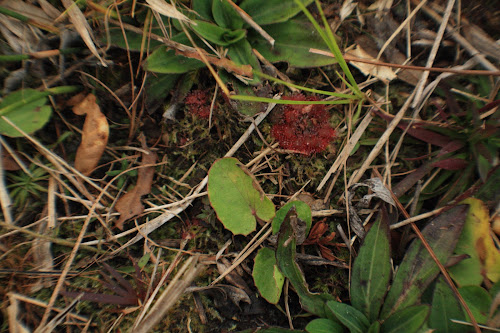Sometimes we can't see the forest for the trees.
 |
| US1 Highway, Flagler County |
Sometimes we can't see the forest for the rooftops
 |
| Breaking Ground Rooftop |
Nature can teach us so many things about biodiversity. With a little bit of wild seed source, always available from bird droppings and wind currents, Her wildflowers thrive even where most don't notice.
The Green Roof shown above has over fifty different plant families represented, well as hundreds of genus and species. Native plants, food plants and wildflowers flourish, providing habitat for insects and wildlife.
Mother Nature knows how to care for her own, even along roadsides and above rooftops.
Take a look at the very first photo in the post here. First glance portrays a lonely FDOT rights of way with grass and a few skinny looking pine trees. But in reality the biodiversity here is exponentially greater than the Breaking Ground Contracting Green Roof with hundreds of plant genus occurring across the plantings.
When I see a wet swale such as the remnant pine flatwoods alongside a highway, adrenalin surges through my veins, working against the beta-blockers I take to protect the smooth muscles of my heart from Marfan Syndrome damage. Even in the dead of winter I know this place will be a living jungle, a damp, rainforest-like wilderness zoo of exotic plants and wildlife.
 |
| Advanced Biodiversity May Not Always Be Visible |
Take another look at the photo. How many species are visible?
Clearly there are pines and mowed grass. Yet the open canopy, sandy nutrient poor soil and high water table come together to provide another, barely visible micro-world full of amazing plants and wildlife.
And I knew that as sure as driving by the other day, I'd be back with cane and camera. One of these days I really am going to invent a more friendly swamp hiking cane or walker for hobblers like myself.
So camera in hand I came back and sat down with the tape measure to find out what was really growing on a one square meter of otherwise barren looking roadside. The richness in biodiversity was mind boggling, for growing under the mower's blade height were tiny wildflowers, unusual native grasses and a host of carnivorous plants.
Nature abhors monocultures of anything. As soon as we try to straighten and organize the landscape, She is at work dropping seed source and encouraging complex communities exhibiting intense interactivity and preforming endless important functions. Tidy gardens, neatly planted green roofs and organized landscapes such as the mowed roadside have little significance in Her quest to create fields of biodiversity. Plant a neat row of flowers and in one month she will have planted and sprouted ten times the varieties of plants in the same row.
As I sat on the damp sandy soil looking across the extreme micro biodiversity I noticed my shorts were wicking up some of the plentiful surface moisture, creating a damp cooling effect, calming my excitement generated adrenalin flashes. But with the winter sun quickly fleeing towards the western horizon I knew my task of identifying all the plant species in a one meter square would be impossible in one afternoon's brief time. In fact, it'd probably take an eternity to just begin to understand the living complexity of the habitat lying before me.
Though a few of the photos are included showing all the wonderful plants, I've saved a surprise for the last.
The meter square bit of sandy soil provided a habitat for many plants.
 |
| Florida Native Wildflower, Bantam Buttons, Syngonanthus flavidulus, Flagler County, January 2012 |
Though not blooming, the beautiful rosette of Bantam Button's leaves covered the ground as far as I could see.
 |
| Vanilla Plant, Carphephorus odoratissimus, Florida Native Wildflower, Flagler County, January 2013 |
Beautiful and fragrant vanilla plant, Carphephorus odoratissimus bloomed profusely even though cut and stunted by maintenance mower's blade, growing side by side with mosses and sundew.
 |
| Vanilla Plant, Carphephorus odoratissimus, Florida Native Wildflower, Flagler County, January 2013 |
Coinwort, Centella erecta added interesting colors and textures while cleaning the water and providing nutritious forage.
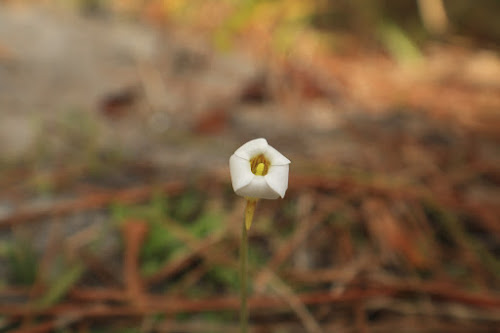 |
| Florida Native Carnivorous Wildflower Butterwort |
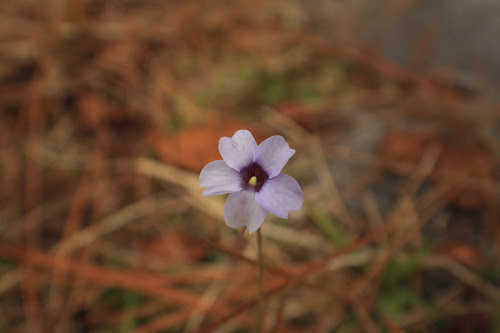 |
| Florida Native Carnivorous Wildflower Butterwort |
The carnivorous plant genus, Butterwort, Pinguicula contributed to the one meter biodiversity as well as different species of Florida's native grass, Panicum. Though at first I thought I'd discovered a great surprise in the small, unusual shaped flower above the tiny little sundew, further examination revealed what I'd expected. The yellow flower belonged to another Florida carnivorous plant genus commonly known as Bladderworts. This particular bladderwort, Utricularia juncea, also known as Southern Bladderwort, present a single thin thread-like stem growing upwards through a stunningly brilliant pink sundew, Drosera capillaris. Two intertwined carnivorous plants, thriving in a seemingly visual desert.
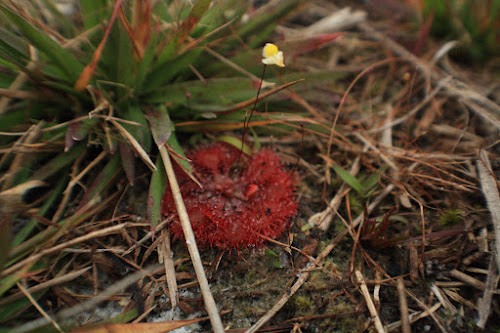 |
| Florida Native Carnivorous plants, sundew and bladderwort |
Nature' complexity is mind-boggling. But then She gave me my real surprise. Reviewing and enlarging the photos on my Canon LCD I noted what I thought was a speck of trash, and there was that annoying feeling of 'must clean the lens and reshoot'. It is hard enough for me to position myself to take the photo the first time. But this was no speck of trash. For on the tiny, barely visible bladderwort stem were even smaller, newborn green tree frogs. I was speechless.
The barren stretch of rights of way was really a jungle of rich biodiversity.
Think you can create a nice little, orderly singular row of flowers or parch of grass? Think again. Nature plays by Her own rules.
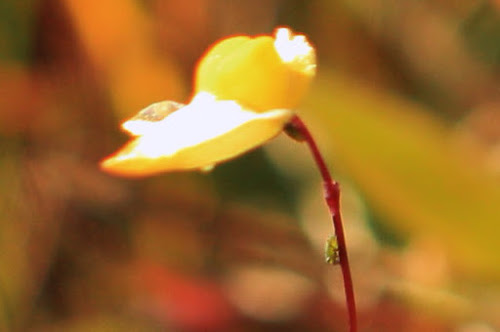 |
| Newly hatched green tree frogs take refuge on a bladderwort stem |










